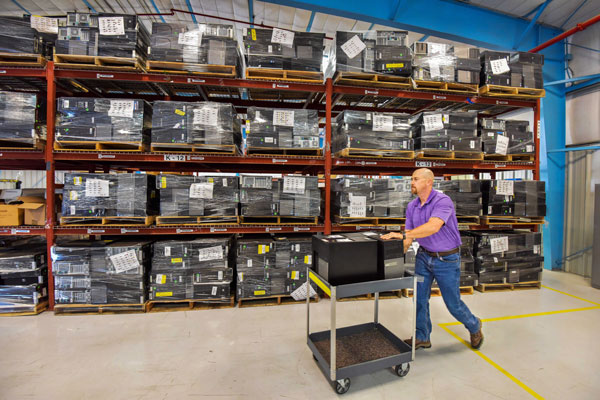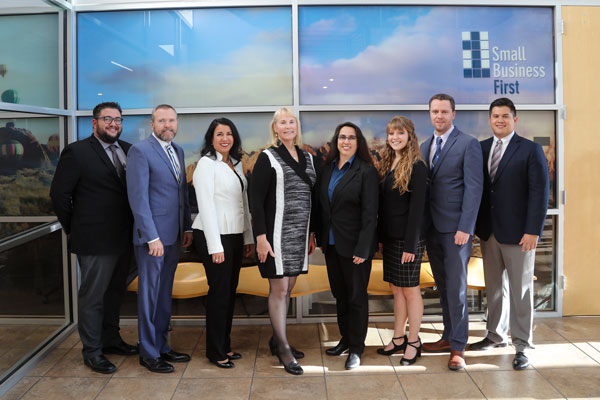
Reducing information technology heterogeneity
Sandia’s IT organizations are in the process of implementing a long-term governance strategy, and efforts are already underway to reduce heterogeneity. In FY19, IT published an approved list of hardware, restricting employees to 21 options, down from 36. Linux versions were reduced from 48 to 12; mobile device restrictions were implemented, and more than 400 unused devices were disconnected; 72 environment, safety and health websites were consolidated down to 40; and a process and standards were established to decommission outdated content on the Sandia Restricted Network. The IT organization’s efforts should result in an annual savings of $2.5 million for the Labs. (10000)
Laboratory Operating System successes
In FY19, Sandia’s LOS team supported 115 projects, achieving $13 million in cost avoidance, 55% reduction in steps, 326 user pain points reduced, 78 standard works created and 469 weeks of cycle time reduced, with an average of 37 days to complete a project. Launched in FY18, LOS is Sandia’s approach to Lean in a research and development environment. Its purpose is to increase the Labs’ capacity to learn, innovate and respond in rapidly changing environments. (10000)
Financial partnership with other labs
In FY19, several laboratories, including Pacific Northwest, Argonne, Lawrence Livermore and Lawrence Berkeley national laboratories, SLAC and Fermi national accelerator laboratories, NASA’s Jet Propulsion Laboratory and the NNSA Office of Management and Budget actively engaged Sandia for financial best practices and expertise. Topics included implementation of a new financial model, indirect sizing and rates, production accounting handbook and inventory streamlining. (10000)
Enhanced fraud risk management environment
Sandia established a charter and working group consisting of six management and operating contractors, the NNSA Office of Management and Budget and DOE to enhance internal controls. The charter and working group positioned Sandia to lead the NNSA complex in demonstrating a cohesive approach for managing fraud risk in federal programs using the Government Accountability Office framework. Sandia’s internal charter and working group are an entity-wide collaboration and include the data analytics working group, internal audit, Office of Management and Budget A-123 program and contractor assurance organizations. (10000)

Base Metal Electrode Capacitor re-spin
In FY19, the BME Capacitors failed qualification testing, impacting the B61-12 Life Extension Program and the W88 ALT 370, which led to the need for a component re-spin and re-baseline on both programs. Beginning in July, a team of project managers and project controllers collaborated with Kansas City National Security Campus to develop an integrated schedule for the affected components, complete a $276 million definitive cost estimate and submit a baseline change proposal to NNSA by September. This was completed in an accelerated timeframe to deliver on the NNSA expectation of implementation by October. (10000)
New Product Introduction success
Sandia co-led the NPI initiative with Kansas City National Security Campus to increase design and production integration, apply lessons learned from past nuclear deterrence programs and augment ND development with industry best practices. The cross-Nuclear Security Enterprise effort is accelerating progress and reducing risk on the W80-4 Life Extension Program. NPI created a list of pre-approved, commercial-off-the-shelf parts; piloted an enhanced process for preparing for technical and programmatic reviews; introduced new product development methods used in industry; facilitated the implementation of Programmatic Tier for W80-4, setting the standard for all modernization programs; and facilitated design failure mode and effect analyses for more than a dozen W80-4 components. (10000)
Workplace Enhancement Council
Mission Services launched a new Workplace Enhancement Council focused on fostering diversity and inclusion, health and wellness, safety and security, community involvement and mentoring. To date, the WEC team has met with the corporate D&I team and the Mission Services Talent Management Steering Committee to ensure alignment. The WEC team publishes a monthly manager email with recommended activities, videos and other resources to facilitate staff discussion and engagement. They also co-sponsored a Sandia presentation, are partnering with Employee Health Services on Labs events and are promoting D&I in the Mission Services quarterly newsletter. (10000)

Computer donations
Sandia’s property organization coordinated the donation of more than 1,200 computing assets and hundreds of monitors and peripherals to 41 schools in New Mexico in FY19. The Labs also donated 61 laptops, 45 monitors, 35 docking stations, 21 printers and multiple boxes of power cords and cables to the Adelante Development Center, a nonprofit organization that supports people with disabilities, seniors and disadvantaged populations across New Mexico. Adelante received these items in time to support their new facility’s grand opening. (10000)
Telecommunications fail-safe measures
In FY19, strong partnership and proactive planning between Sandia/CA and Sandia/NM ensured continued connectivity following a CenturyLink equipment failure in Santa Clara, California. This equipment failure took down two fiber connections carrying Sandia’s primary and secondary paths for inter-site connections. The traffic failed over to a third link provided by a second carrier, as planned. The Labs’ intersite configuration, which supports all traffic, but primarily enterprise telephone and the Sandia Restricted Network, Sandia Partnering Network and encrypted Sandia Classified Network, remained resilient and experienced no data loss. Critical work was uninterrupted. (10000)
Project management maturation
Sandia has categorized 99% of its projects after integrating the existing Project Mission Assurance Category Evaluation and Project Rigor Evaluation tools into a single tool, PrE V3.0, setting Labs-wide standards for project execution. Sandia placed a subcontract for a Labs-wide portfolio management tool and awarded two contract purchase agreements for Agile project management support. Sandia is on the path to implementing a portfolio data management tool that will enable mission-specific portfolios of work that are currently siloed to be viewed and managed from a Labs-wide perspective, to ensure consistent and predictable success of all missions. The project rigor evaluation, portfolio data management tool and contract purchase agreements are steps to ensure processes and tools enable the Labs to meet deliverables and fulfill commitments transparently. (10000)

Small business outreach
In FY19, Sandia exceeded all socioeconomic procurement goals, awarding 61.15% of subcontract dollars, valued at more than $847 million, to small businesses. Sandia received an Office of Small Disadvantaged Business Utilization Director’s Excellence Award at the 18th annual DOE Small Business Forum & Expo in recognition of its efforts to educated suppliers on doing business with the Labs. More than 431 small businesses engaged with Sandia in FY19 through small business forums, events and presentations at supplier community events. (10000)
Sandia Classified Network enhancements
The Labs’ information technology organizations made several improvements to the Sandia Classified Network to improve speed, increase capacity and enhance security. As part of these improvements, two project management tools were deployed on the SCN in FY19, creating greater efficiency by eliminating project management coordination in two environments and reducing risks associated with tracking classified project timelines and budgets in an unclassified environment. (10000)
Key Labs-level financial planning
Sandia implemented enhancements to key financial planning processes, including projections and indirect budgeting, to enhance effectiveness and strengthen controls. Additionally, Sandia proactively enhanced its annual indirect planning process to lay a foundation to ensure the Labs achieves the 5% congressional indirect reduction in FY20. (10000)
Tiered Accountability
Sandia continues to find value in the Tiered Accountability process and boards, Sandia’s approach for communicating regularly to assess performance, identify problems and respond rapidly using a tier structure. The Laboratory Operating System team completed maturity activities for Tiers 3, 4 and 5, summarized results and created improvement action plans in FY19. Tier 5 transitioned to an electronic board, improving content, experiences and metrics and altering content and flow to better align with the spirit and intent of Tiered Accountability. (10000)